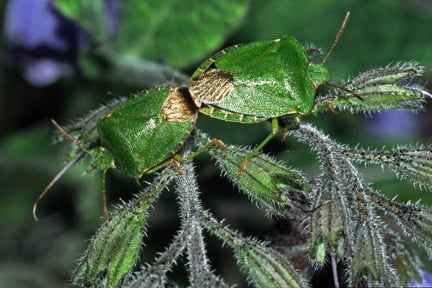
Quick facts
Common names - Green shieldbug and southern green shieldbug
Scientific names - Palomena prasina and Nezara viridula
Plants affected - Green shieldbug various plants. Southern green shieldbug runner bean, tomato and raspberry; also on the seed heads of ornamental plants
Main symptoms - No damage is caused by the green shieldbug. The southern green shieldbug may cause distorted bean pods and damaged fruits
Most active - April to October
What are green shieldbugs?
There are more than 40 species of shieldbug in Britain, several species are common in gardens and are part of the they support. The name shieldbug is due to the shield-like shape of the adult insects when seen from above. All true bugs have sucking mouth parts and most shieldbugs feed on plant although a few are predatory, most do not damage plants and can be encouraged in gardens. An identification guide can be found at British Bugs. There are other shieldbug species present with either greenish coloured adults or instars, however, this page focusses on the green shieldbug and the southern green shieldbug as these adults are frequently found in gardens and look very similar.
The green shieldbug and southern green shieldbug feed on sap and can be found on a wide range of plants. The adults, when viewed from above, have a distinctive shield-like shape. One shieldbug of concern is the brown marmorated stink bug, more information can be found here.
Symptoms
With these insects you are less likely to spot signs of their presence and more likely to encounter the adult insects or their nymphs. The two species of green shieldbug found in Britain can be difficult to distinguish.
Green shield bug
- Adult green shieldbug (Palomena prasina) are broad, flattened and green with a strongly contrasting blackish brown darker area at the rear end, where the hind wings cross
- The adult insects are about 10 mm (about 3/8 in) long and are often seen basking in the sun in late summer on a wide variety of plants
- This insect is to Britain and is of widespread occurrence, especially in southern England
- Nymphs of the native green shield bug have a rounded shape and are pale green, with some black markings during the earlier instars
- It overwinters as adults, which usually turn brown. These are sometimes found in buildings
Southern green shield bug
- In 2003 the southern green shieldbug (Nezara viridula) was found breeding for the first time in the London area
- This arrival from mainland Europe is up to 12 mm (about ½ in) long, making it slightly larger than the green shield bug
- The adults are uniformly green and lack a dark area at the rear end of the body
- The nymphs of southern green shieldbugs are green or black with many white, yellow or pinkish-red circular markings on their upper surface
- This species can cause damage to some vegetables, especially runner and French bean pods, but it remains to be seen whether it will become established to the extent that it becomes a problem in Britain
- Whilst this bug can be a problem in other parts of the world, the evidence so far in mainland Britain is that the southern green shieldbug does not become numerous until late summer or early autumn, by which time beans are coming to the end of their cropping period and so little damage is caused
- Similar to the green shieldbug this species also overwinters as adults, which usually turn brown. These are sometimes found in buildings

Management
- The green shieldbug is harmless, it is part of the a healthy garden can support and control measures are not required
- The southern green shieldbug has not yet become numerous enough to cause damage to crop plants. Large numbers have only been seen from August onwards when crop damage is likely to be insignificant and therefore management is unlikely to be necessary
Biology
- Sometimes mistaken for beetles, shieldbugs belong to a different group of insects, the Hemiptera or true bugs, these all have sucking mouthparts
- Green shieldbugs feed by sucking from a wide range of plants but the green shieldbug causes no noticeable damage to cultivated plants, even when numerous
- Both types of green shieldbug overwinter as adults but before seeking sheltered places they are often seen in late summer and autumn sitting on plant foliage in the sun. They often turn brown when overwintering
- They are also active in early summer when they lay small clusters of eggs on the undersides of leaves
- The nymphs have a rounded body shape and gradually take on the adult appearance as they develop
- In recent years the green shieldbug has become more abundant and widespread in Britain
- The introduced southern green shieldbug has become established, and is likely to become more widespread, at least in southern England
- There are about 30 other species of shieldbugs, which are brown or yellowish green with reddish markings. Some of these can also be found in gardens, none of these will damage garden plants
- Some more information on British shieldbugs can be found at the British Bugs website







